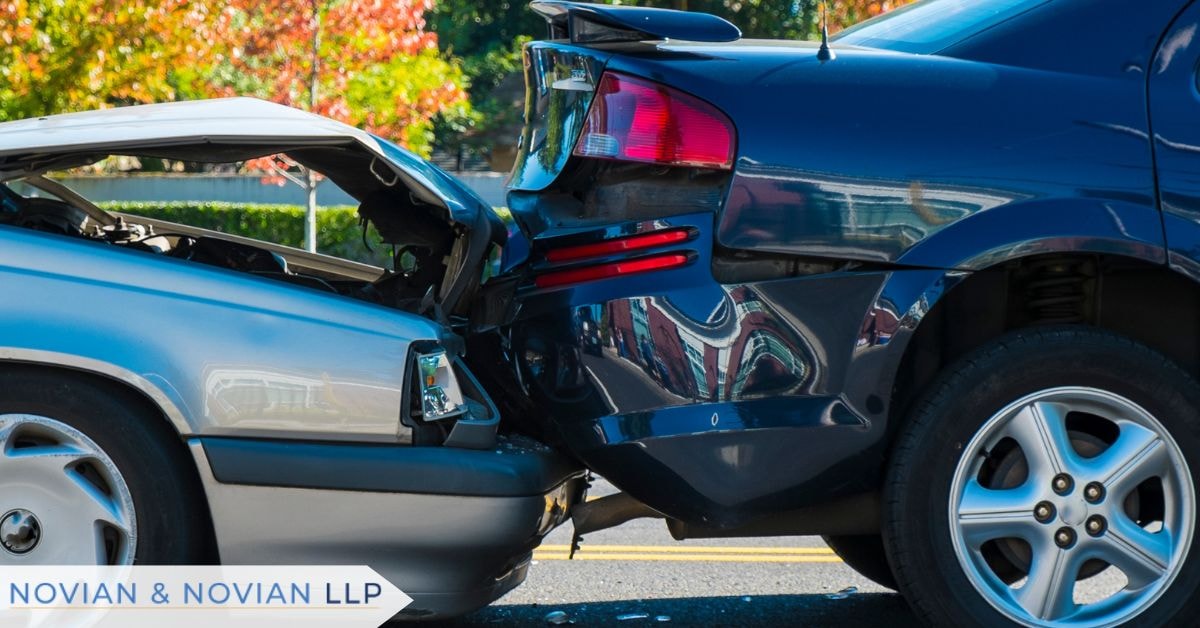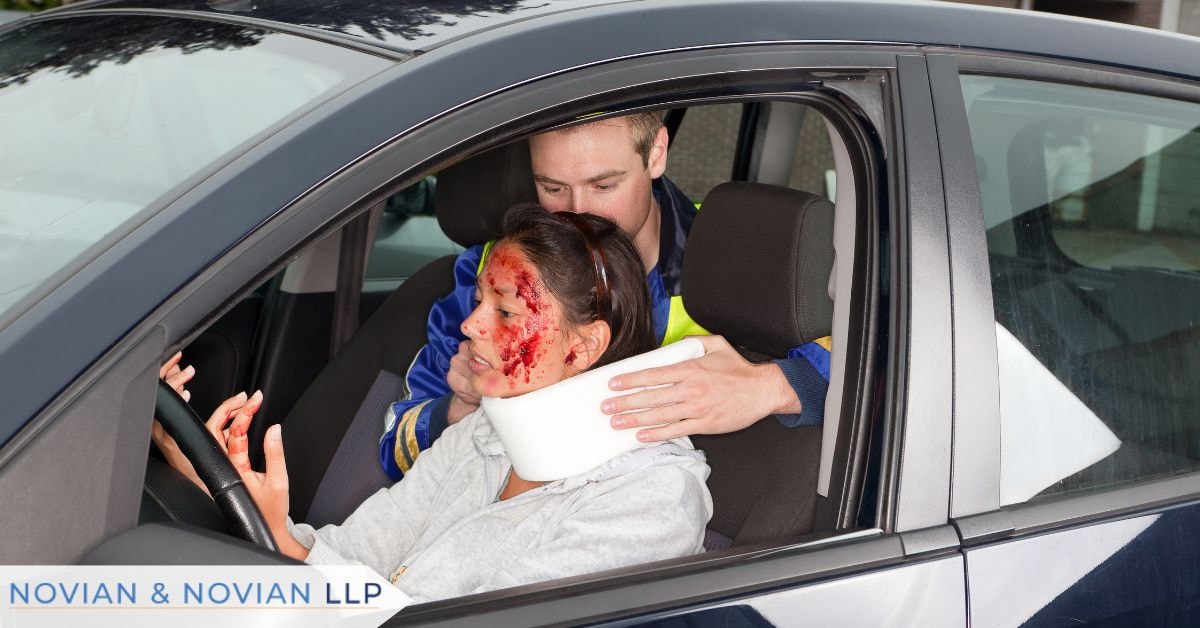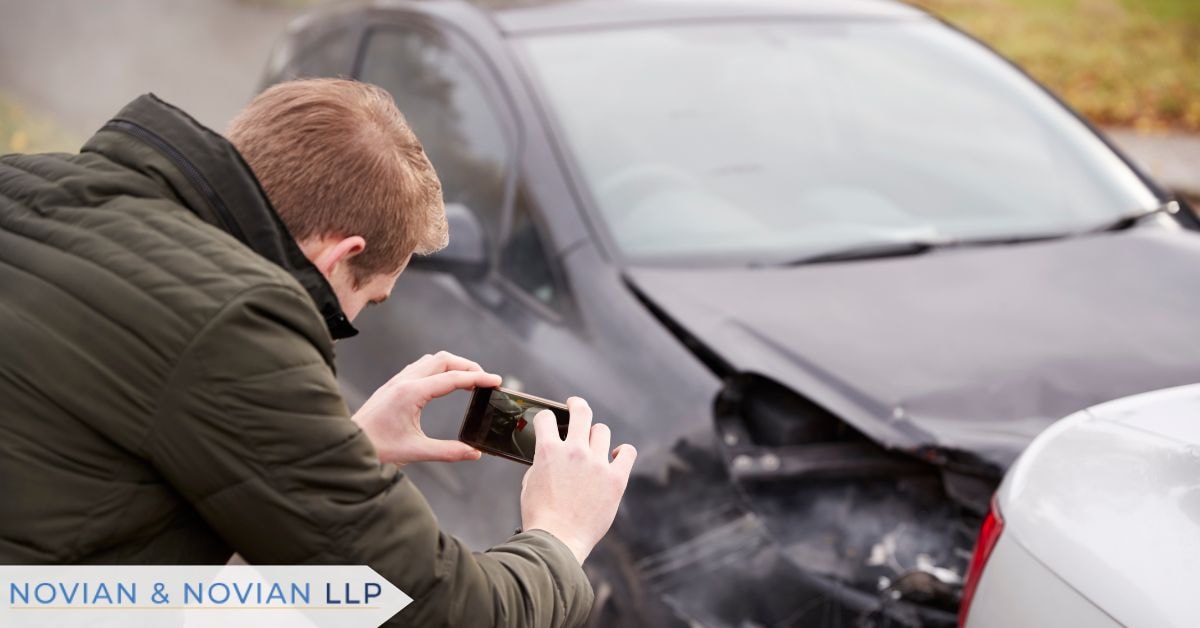
Rear-end collisions are one of the most frequent types of car accidents. While they can range from minor fender-benders to severe crashes, the aftermath of these accidents is rarely straightforward. Injuries, vehicle repairs, and emotional distress can pile up quickly and leave victims overwhelmed.
Settlements for rear-end collisions vary depending on the circumstances, including the severity of injuries, the extent of property damage, and the clarity of liability. For example, a minor accident resulting in whiplash and a short recovery period might settle for around $15,000. On the other hand, more serious accidents involving long-term medical care or permanent injuries can reach hundreds of thousands of dollars.
If you’ve been involved in a rear-end collision, it is important to seek legal advice to understand your rights and options. At Novian & Novian, we specialize in helping victims of catastrophic injuries in California achieve fair compensation. With over 35 years experience, our team will guide you through the process. Schedule a free consultation with us today!
This post will cover rear-end collision settlement examples. We will also give the average cost of a rear-end collision settlement and the factors that impact the cost.
What Is a Rear-End Collision?
A rear-end collision occurs when one vehicle crashes into the back of another. It is among the most common types of traffic collisions and often results from the rear driver’s failure to maintain a safe distance or pay adequate attention to the road.
Rear-end collisions often happen because of negligent driving behaviors. This includes distracted driving, tailgating, sudden stops, speeding, and weather conditions.
The impact of a rear-end collision often causes injuries, even in seemingly minor accidents. Common injuries include whiplash, back injuries, spinal cord injuries, head injuries, and soft tissue injuries.
What Is the Average Rear-End Accident Settlement Amount?
The average settlement amount for a rear-end accident depends on the severity of the injuries and the extent of property damage. It could also depend on other factors like medical bills, lost wages, and emotional distress.
Settlement amounts typically fall into three categories. For minor injuries, such as soft tissue injuries like whiplash, settlements range from $10,000 to $50,000. These amounts cover medical expenses, vehicle repairs, and short-term physical therapy. Moderate injuries, such as back injuries or herniated discs, requiring more extensive treatment and time off work, usually result in settlements between $50,000 and $100,000. Severe or catastrophic injuries, such as spinal cord injuries, traumatic brain injuries, or multiple fractures, often lead to settlements exceeding $100,000, as victims may face extensive medical bills, long-term care needs, and significant lost wages.
Do Settlement Amounts Vary by State?
Yes, settlement amounts for rear-end collisions can vary based on the state where the accident occurred, as different states have unique laws and systems for determining compensation. For example, California operates under a pure comparative negligence system. Here, settlements for rear-end collisions often reflect the shared responsibility of the parties involved. You can expect amounts ranging from $3,000 to several million dollars from a car accident in California. Similarly, Washington uses a comparative negligence system, and settlements often vary based on the extent of injuries sustained, vehicle repairs, and the at-fault driver’s liability.
In Texas, settlements depend on the fault system. In this case, the at-fault driver’s insurance coverage plays a key role in determining compensation. Victims with significant injuries in rear-end car accidents often receive settlements that cover medical attention, physical therapy, vehicle repairs, and damages for emotional distress.
On the other hand, Florida operates as a no-fault state. This requires accident victims to rely on personal injury protection (PIP) for their initial medical expenses, but serious injuries often lead to lawsuits where settlement amounts reflect the severity of the damages.
Each state has its nuances in determining compensation for motor vehicle accidents, which is why accident victims should consult experienced car accident attorneys familiar with state laws. From skid marks at the accident scene to police reports and medical records, a thorough understanding of the legal process and evidence is essential for securing fair settlements.
4 Rear-End Collision Settlement Examples
Settlements for rear-end collision accidents can vary widely depending on the severity of the injuries, property damage, and the circumstances of the accident. Victims of rear-end collisions are entitled to fair compensation for medical bills, lost wages, pain and suffering, and property repairs. Below are four examples illustrating typical settlements based on the extent of injuries and damages.
1. Minor Injury and Minimal Property Damage
In cases involving minor injuries and limited property damage, settlements are typically lower. For example, Mary, a client of ours, suffered whiplash and minor neck strain after being rear-ended and required physical therapy for four weeks. The property damage was limited to cosmetic repairs to the rear bumper, with repair costs totaling $1,000.
The settlement in this case amounted to $8,000. Some of the key factors that determined the settlement amount include the lack of a dispute over fault, low medical expenses, and the victim’s quick recovery. Rear-end collisions like this, while less severe, still require victims to seek medical attention and consult experienced car accident attorneys to secure fair settlements for their medical expenses and vehicle repairs.
2. Moderate Injury with Lost Wages
Rear-end accidents resulting in moderate injuries often lead to higher settlements. For example, a former client of ours experienced soft tissue injuries, a concussion, and persistent back pain, requiring chiropractic care for three months after being in a rear-end collision.
He was unable to work for four weeks, resulting in $3,000 in lost wages. The vehicle was declared a total loss, with replacement costs of $15,000. The insurance company settled for $45,000, taking into account clear liability, detailed medical documentation, and verifiable lost income. Victims of such accidents should work with a personal injury attorney to ensure that their lost wages, medical bills, and property damage are fully covered by the at-fault driver’s insurance coverage.
3. Severe Injury Requiring Long-Term Treatment
Severe rear-end collisions often result in higher settlements due to the extensive medical bills and long-term impact on the victim’s quality of life. We once had a client who, following a rear-end collision, suffered a herniated disc that required surgery and ongoing physical therapy, leading to a permanent reduction in mobility.
He missed six months of work and faced reduced earning capacity for the future. His vehicle sustained significant damage, with repair costs of $10,000. The rear-end accident settlement amounted to $150,000, reflecting high medical costs, future damages for reduced earning potential, and expert testimony to support the claim.
4. Traumatic Brain Injury (TBI) with Cognitive Impairments
Rear-end collisions involving catastrophic injuries, such as traumatic brain injuries, result in some of the highest settlements. In one such case, one of our clients suffered a severe TBI, which led to memory loss, impaired speech, and difficulty performing daily tasks.
Our client was permanently unable to work in any capacity, and medical costs, including extensive hospitalization, rehabilitation, and psychological therapy, totaled $800,000. The settlement reached $3.2 million, factoring in expert opinions on cognitive impairments, high non-economic damages for pain and suffering, and future care costs.
These significant injuries demonstrate the importance of securing experienced legal representation to ensure victims receive compensation that covers all aspects of their recovery, including medical attention, emotional distress, and long-term financial security.
What Impacts Car Accident Settlement Amounts?
Car accident settlement amounts can vary widely, depending on several key factors that influence how compensation is calculated. These factors ensure that victims receive fair compensation for their injuries, financial losses, and emotional distress.
An example of such factors is the severity of injuries. The severity of injuries sustained in a car accident is one of the most significant factors in determining settlement amounts. Minor injuries, such as soft tissue damage, generally result in smaller payouts, while severe injuries, such as traumatic brain injuries, spinal cord injuries, or permanent disabilities, lead to substantially higher settlements. The extent of injuries also impacts the length of recovery and the victim’s ability to resume normal activities, which are key considerations in car accident claims.
Medical expenses also play a key role in settlement calculations. These include costs for emergency room visits, surgeries, physical therapy, and any required rehabilitation. If the victim requires ongoing or future medical treatment, these anticipated expenses are also factored into the settlement. Extensive medical bills and long-term care needs typically result in higher compensation amounts to ensure that accident victims are not financially burdened by their recovery.
Furthermore, lost wages due to time off work during recovery significantly impact car accident settlements. For victims who cannot return to their previous jobs or suffer a reduction in earning capacity, compensation may include the financial losses associated with future income. This is especially true for severe injuries that prevent the victim from maintaining their standard employment or require a career change with lower earning potential.
Car accident settlements often include compensation for pain and suffering, which accounts for the physical and emotional distress caused by the accident. Non-economic damages like anxiety, depression, and loss of enjoyment in life are evaluated based on the severity of the injuries and their impact on the victim’s overall quality of life. Severe injuries that result in long-term or permanent disability typically lead to higher pain and suffering compensation.
Insurance policy limits also play a significant role in determining the maximum payout a victim can receive. If the at-fault driver’s insurance policy has low limits, the settlement may be capped, even if the victim’s damages exceed those limits. In such cases, victims may need to pursue additional compensation through their own underinsured motorist coverage or by filing a personal injury lawsuit.
Additionally, the determination of fault and negligence can impact a settlement. If the at-fault driver’s liability is clear, such as in a rear-end collision, the settlement process may be more straightforward. However, if the fault is shared between parties, compensation may be reduced proportionally under comparative negligence rules. Having a police report and evidence from the accident scene can strengthen a victim’s case and ensure they receive the compensation they deserve.
How to Maximize Your Rear-End Collision Settlement
To maximize the average payout of your rear-end collision settlement, you must seek medical attention. Even if your injuries appear minor, seeking medical attention promptly is important. Many injuries, such as whiplash, soft tissue injuries, or back injuries, may not manifest immediately but can worsen over time. Medical records serve as evidence in personal injury claims, proving the extent of injuries sustained and justifying your medical expenses. Insurance companies often challenge claims without proper documentation, making immediate medical care vital to your settlement process.
It is also helpful to gather and document evidence, as thorough documentation is key to building a strong case for your rear-end collision settlement. Start by collecting a police report, as it establishes an official account of the accident and often identifies the at-fault driver. Then, take photos of the accident scene, skid marks, and any visible injuries. Similarly, gather witness statements if possible, as these can corroborate your version of events. All evidence strengthens your claim, whether it’s for medical bills, property damage, or non-economic damages like emotional distress.
Importantly, consider legal representation. Rear-end collision accidents often involve complex negotiations with insurance companies, which may try to offer lowball settlements to close claims quickly. A personal injury attorney can help you navigate the legal process, evaluate your car accident case, and negotiate for fair compensation that accounts for lost wages, medical expenses, and pain and suffering. Legal representation ensures that accident victims don’t accept unfair offers and receive the maximum payout possible.
The Role of an Attorney in Rear-End Collision Cases
An attorney plays a critical role in securing fair settlements for accident victims. They handle the complex negotiations with insurance companies, ensuring that every aspect of your claim is addressed. Attorneys bring legal expertise to accurately calculate settlement amounts, considering not just medical expenses and property damage but also non-economic damages like emotional and physical distress.
When searching for a personal injury lawyer, look for someone with a proven track record in rear-end car accidents. A reputable attorney will offer a free consultation to discuss your case and provide guidance on your legal options. Their knowledge of state laws, such as the pure comparative negligence system in states like California, ensures that your settlement reflects all aspects of your accident.
How Is Fault Determined in a Rear-End Collision?
Fault in a rear-end collision is typically determined by examining evidence, witness statements, and traffic laws. In most cases, the rear driver is presumed at fault because they are responsible for maintaining a safe following distance to avoid accidents. However, exceptions can occur if the leading driver’s actions contributed to the collision, such as making a sudden stop without reason, failing to signal, or driving with malfunctioning brake lights.
Evidence such as skid marks, damage to the vehicles, and the police report plays a critical role in determining fault. Witness statements and any available video footage can also provide additional context to establish negligence.
In states with comparative negligence systems, such as California, the fault may be shared between parties, and compensation is adjusted based on the percentage of liability assigned to each driver. Consulting a personal injury attorney can help clarify fault in more complex cases and strengthen your claim for fair compensation.
How Long Does It Take To Settle a Rear-End Collision Case?
The time it takes to settle a rear-end collision case can vary significantly depending on several factors. Cases involving minor injuries and clear liability may be resolved within a few weeks to a few months, especially if the insurance company offers a fair settlement early on. However, more complex cases with severe injuries, disputed fault, or extensive negotiations can take several months to a year or longer to resolve.
Key factors that can influence the settlement timeline include the severity of injuries, the duration of medical treatment, and the willingness of the insurance company to negotiate. If the case involves litigation, the process can extend even further, depending on court schedules and the specifics of the case. Legal representation can expedite the process by managing communications with the insurance company, ensuring timely documentation, and avoiding unnecessary delays.
Need a Personal Injury Attorney to Maximize Your Settlement?
Securing a fair settlement after a rear-end collision requires understanding key factors such as fault determination and the role of legal representation. Whether you’re dealing with minor injuries or navigating the challenges of a severe or catastrophic injury, the legal process can be overwhelming. From gathering evidence and negotiating with insurance companies to ensuring all aspects of your damages are accounted for, having a knowledgeable advocate can make a big difference.
And while every case is unique, the proper steps to ensure you maximize your settlement remain the same.
At Novian & Novian, we specialize in handling rear-end collision cases and personal injury claims. Our experienced personal injury attorneys in California understand California’s legal process and are committed to helping accident victims achieve fair compensation for medical expenses, lost wages, and emotional distress. Contact us now for a free consultation.
Contact Us
Have questions about this post? Novian & Novian is a full service law firm in Los Angeles with clients that span the country. Contact us today for a free consultation.
Contact Us
Have questions about this post? Novian & Novian is a full service law firm in Los Angeles with clients that span the country. Contact us today for a free consultation.






